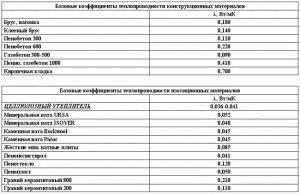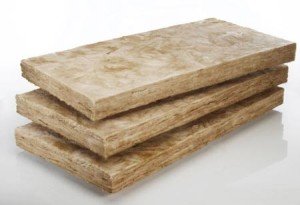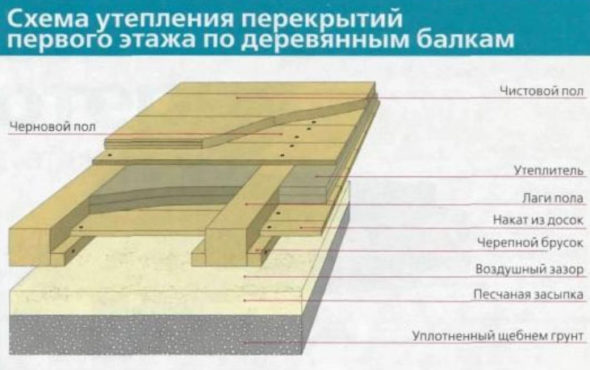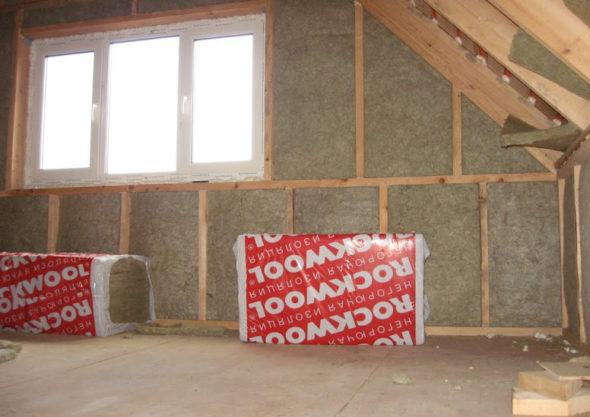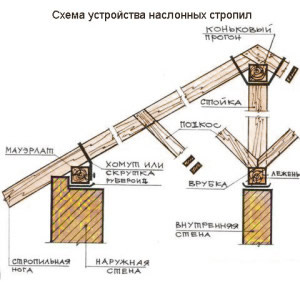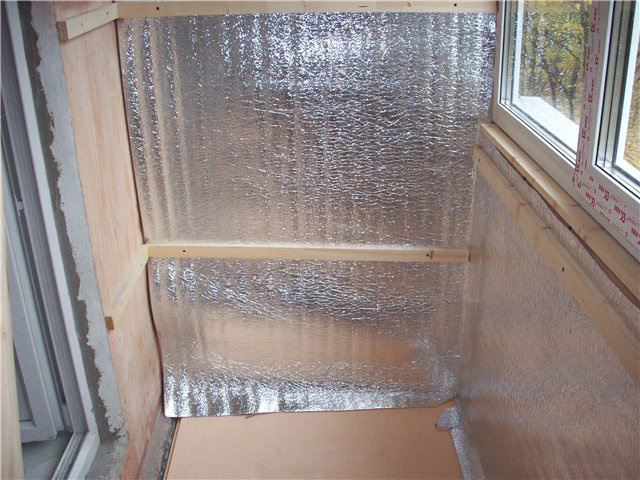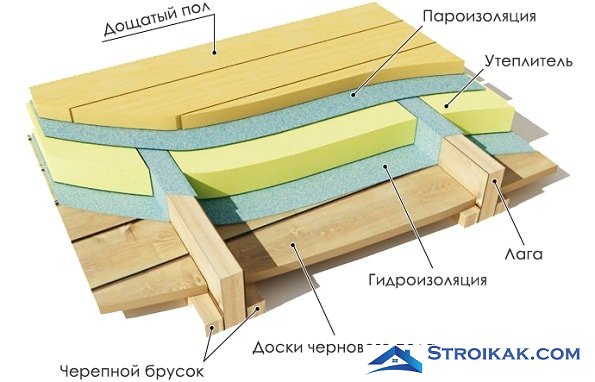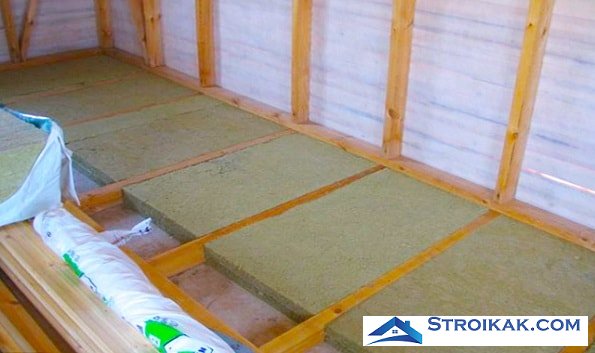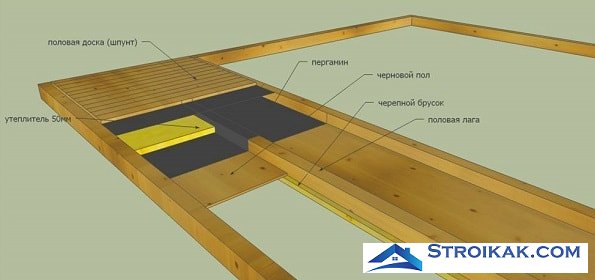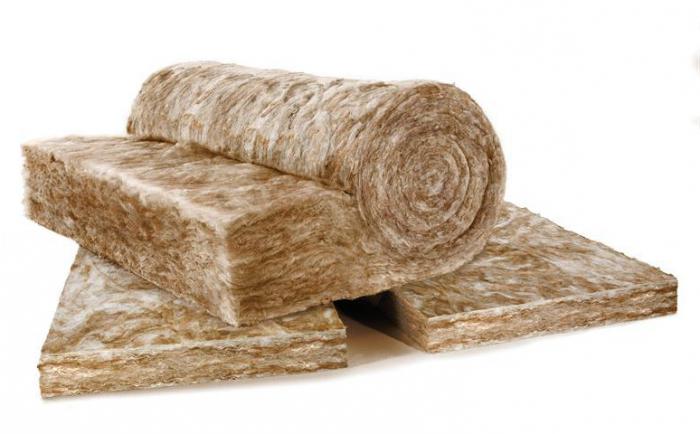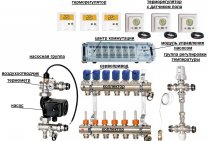How to insulate the ceiling and attic floor
In a heated private house, a large amount of heat will escape through the roof, if measures are not taken and the ceiling of the upper floor is not properly insulated. The physics of the process is known: heated and lighter air is displaced into the upper zone of the room, bordering the cold attic, where it gives off heat to the uninsulated floor. To prevent this from happening, it is necessary to arrange a barrier in the form of a layer of thermal insulation on the path of the heat flow. This material will just discuss how to properly insulate the ceiling or attic floor with your own hands and the better to isolate this horizontal structure.
Types of insulation and calculation of materials for the second floor
Comparative characteristics of the thermal conductivity of various thermal insulation materials. Click on the photo to enlarge.
The attic loses heat much more actively than the rooms on the lower floor. The reason is simple - there is a roof above it, so the area of contact with the external environment is an order of magnitude larger. Thus, high-quality thermal insulation is required, but thermal insulation cannot be neglected, otherwise hot air will penetrate inside in hot weather.
Calculations can be made using the formula for the design heat transfer resistance of the wall - Rreq = (1 / A1) + (L / k) + (1 / A2). In this case:
A1 - heat transfer coefficient for the entire plane of the inner wall - 8.7 W / m C; A2 - a similar coefficient, but related to the outer wall - 23 W / m C; L is the thickness of the insulation (in meters); k is the thermal conductivity coefficient.
https://youtube.com/watch?v=6EWQh8Ct8rw
To determine the required thickness of the insulation layer for the second floor, it is required to compare the thickness of the wall with the resulting calculations. It is also worth considering the type of material from which the building was built. Further, it is recommended to immediately calculate the surface area to be insulated, excluding the parameters of window and door openings.
Then comes the turn of the choice of insulation. Since the attic will be residential, the heat insulator must also be environmentally friendly. To make sure of this, you need to take a hygiene certificate from the seller, in which the following points are noted:
- environmental suitability of the insulation;
- thermal conductivity class;
- suitability for hygroscopicity.
Styrofoam
In this case, the use of foam is not recommended due to its toxicity. Especially in cases where the attic of the house is located above the bath - high humidity and easy flammability are contrary to safety requirements.
For the second floor, fiberboards are excellent, which are often mounted under the roof. Their insulation guarantees good sound insulation performance, as well as the absence of deformations during sudden temperature changes. Installation is convenient and does not take much time - you can cut the pieces necessary for the configuration with an ordinary knife, and dowels are used for fixing. The front side of fiberboard is smooth, which allows you to glue any wallpaper on it. The low price of insulation also plays an important role.
If fiberboard is used for floor insulation, then the old coating is first torn off, after which 2 layers of roofing material are laid, which are covered with fiberboard boards. A new floor covering is already being installed on top of them.
glass wool
This is the cheapest insulation, suitable for those whose budget is strictly limited. The material itself has excellent fire resistance and thermal conductivity. A serious disadvantage is the inconvenience of work, since glass chips and dust are poured from cotton wool, so during work it is necessary to be dressed in protective clothing, goggles and gloves. It is worth remembering that it will be impossible to clean the clothes from glass crumbs, so they will have to be thrown away.
mineral wool
Mineral wool as a heater. Click on the photo to enlarge.
This wool, made on a basalt basis, is considered the best option for a wooden house. Its manufacture comes from synthetic fibers that are mixed with crushed stone chips. The density of the insulation should range from 18 to 45 kg / m³. It is environmentally friendly, does not deteriorate by pests and rodents, and also has excellent sound insulation performance.
Insulation of the 2nd floor with mineral wool is absolutely safe. Minus - a higher cost compared to glass wool.
Regardless of the material used, in the process of warming the second floor, a vapor barrier is necessary - a vapor barrier membrane or a vapor barrier film. Its task is to prevent the formation of condensate inside the heat-insulating layer during the exit of warm air from inside the room to the street. Otherwise, the characteristics of the heat insulator are sharply reduced.
When using a fibrous type insulation, a windproof film will be additionally required, since in conditions of strong wind the fibers are not able to effectively retain heat. If the insulation is mounted in several layers, there is no need to glue the film between them.
Insulation of the attic floor with foam
The process according to the installation technology is similar to the insulation of the attic floor with polystyrene foam.
The advantages of these materials:
- low cost;
- ease of operation;
- waterproof.
Among the disadvantages: flammability.
Attic floor insulation technology with polystyrene foam or polystyrene foam
The process of installing rigid foam-based insulation is more than simple and can be done by hand. The work can be divided into two stages:
surface leveling. To ensure high-quality insulation, there should be no significant irregularities on the floor of the base. You can eliminate such differences by performing a screed with a sand-cement mortar.
slabs are laid butt-to-butt or between beams. The presence of a bar increases the strength of the floor.
Tip: carefully seal any seams, incl. joints with beams. Bypassing the obstacle, try to cut holes as accurately as possible. A homogeneous thermal insulation layer retains heat better.
Insulation of the attic floor with foam plastic Draft coating
Styrofoam must be protected from destruction with a film in a non-residential attic. In a frequently used or residential attic, you need to somehow move, so it is better to equip an OSB subfloor or a sand-cement screed over polystyrene foam or polystyrene foam.
Interfloor insulation
We recommend that you start by sealing the hardwood floor between floors. First you need to dismantle the floor, then lay a layer of vapor barrier material, after which the free area is filled with a heat insulator. For this purpose, the following materials are used:
- Styrofoam;
- extruded polystyrene foam;
- foiled polyethylene foam;
- mineral wool.
Then the vapor barrier layer is laid again and the floor covering is laid. The next step will be the thermal insulation of the walls of the first and second floors.
How to insulate the walls of a private wooden house
Wall decoration with insulation can be done from the outside or inside of the building. The most effective is external thermal insulation, the easiest way to do this is with foam plastic or mineral wool.
The internal processing of the walls in the room is carried out in stages. First, all cracks are sealed, the walls are etched with an antiseptic solution in order to eliminate rotting and mold formation. Then, thin glazing beads are attached horizontally to the surface to ensure ventilation, and a vapor barrier is tightly fixed to them. After that, the installation of vertical racks begins, between which mineral wool slabs are laid, a layer of vapor barrier is fixed on top of them.From above everything is covered with drywall or clapboard.
Finishing the attic floor is carried out similarly to sealing the interfloor partition. An important nuance: when laying the vapor barrier layer, it is necessary to do it with a rough surface outside in order to remove steam from the private house to the outside, but at the same time stop the penetration of moisture from the side of the roof into the heat-insulating material.
For thermal insulation work on the ceiling, the following building materials are used:
- mineral wool;
- foam concrete;
- expanded polystyrene;
- support plates;
- ecowool.
A layer of insulation is attached directly to the ceiling, and a lining is made on top with plaster or other finishing materials. High-quality insulation of the ceiling between the second and first floors will keep the heat in the room.
Before starting construction work on the insulation of the second floor of a summer house or a private house, it is necessary to carefully plan the procedure for their implementation, calculate and purchase the required amount of raw materials. At the planning stage, we recommend using a photo with instructions for each stage of work.
See how you can insulate the balcony with your own hands.
Save
Save
Save
Save
Save
Save
Save
Save
How to insulate an attic
What insulation is suitable for the second floor and attic of a log house? Usually, in this case, standard materials are used, traditionally used for thermal insulation of the roof in a wooden house. This:
- mineral wool;
- expanded clay;
- ecowool;
- expanded polystyrene;
- polyurethane foam.
We talked about each material in more detail in the article about roof insulation in a wooden house.
If thermal insulation is carried out in the attic, located above the bath, then there are slightly different rules in the choice of material. Not every insulation can work effectively in conditions of high humidity and extreme temperatures.
For example, one of the best materials for insulation in a wooden house, mineral wool, in a sauna will very quickly lose its consumer properties. This material strongly absorbs moisture, which is abundant in the steam room. They can finish the walls, but the insulation of the attic floor of the bath is best done with moisture-resistant polystyrene foam.
The company "Master Srubov" offers residents of the Moscow region to use professional services for home insulation. We guarantee high quality workmanship and fast results. To leave your application, go to the "Contacts" section. There you will find all our data.
Calculate the cost of painting and insulating your home right now
Internal work
Scheme of the device of layered rafters
At the moment there are 3 most famous methods.
The first - thermal insulation is laid between the rafters. The material must adjoin the chimney, windows and walls quite tightly, and there must also be a 2-centimeter gap between the layers of hydro and thermal insulation. It is also necessary to take into account the expansion of the material, which can reach 10-30 cm, like with mineral wool, for which an appropriate gap must be left. If the width of the lag does not allow this, linings are stuffed on them. The main thing is to prevent sagging of the insulation mats.
The second is complex work. They provide for the use of materials that, along with the main property, have indicators of hydroprotection. This necessitates a more thorough installation of thermal insulation, since the question arises regarding air circulation. A similar approach will also “eat up” part of the room on the 2nd floor, because the heat insulator with the rest of the materials is mounted by seam joints either above or below the rafters.
The third is the installation of insulation over the rafters. It allows you to save the volume of the room and ensure the reliability of waterproofing.
Working with mineral wool
Warming of the 2nd floor of any wooden house in terms of area is possible by means of mineral wool.
First you need to purchase mineral wool, bring it to the place of work and open the package – no comments. The material will gain air and noticeably increase in volume. Protective clothing must be put on before work, and the room itself must be well ventilated.
Next, you need to check the location of the rafters of the 2nd floor with a long aluminum profile. It is required to attach it to the extreme ones and see that all the rafters touch the profile.
After that, a vapor barrier film is stretched with its obligatory alignment and fixation with a stapler. The overlap during laying should be 10 cm, and the joints must be glued with a special adhesive tape (but not with ordinary tape!).
To frame the window openings of the house, a crate is mounted in increments of 40-60 cm. The vertical bars are fixed with self-tapping screws, while a base bar is stuffed under them, where the drywall and film will meet. The entire frame is filled with a heat insulator.
A frame for stuffing drywall is created on the end side of the house in increments of 50 cm. The first slab of material is clamped with profiles. A vapor barrier film is glued on top of the thermal insulation. All joints and the perimeter are glued with the same adhesive tape. Drywall is fixed with self-tapping screws. This is where the insulation ends.
Upon completion of these works, you can proceed to the decoration of the house and the installation of heating equipment.
Thermal insulation of the loggia and windows on the second floor
The “weak” point of any room and attic, including glass surfaces, window and door openings. Through them, the lion's for warmth from the premises flows. Even if initially plastic double-glazed windows were installed in the window and doorway of the loggia, it is necessary to additionally insulate the slopes.
Any material can be chosen to insulate the window and door slope on the 2nd floor of a wooden building, but experts recommend using polystyrene foam, polystyrene foam or any other cellular product.
The thermal insulation of the loggia is carried out by analogy with the work aimed at insulating the pediment.
Thermal insulation of the walls of the second floor of a wooden house
To insulate the walls on the second floor of a wooden private house, 2 technologies are used at once:
- internal thermal insulation, which is produced in a ventilated way;
- external insulation, there are two options for execution: dry and wet.
Internal thermal insulation is started when it is not possible to perform external work to preserve heat inside the building.
The popularity of interior work is low for a number of reasons:
- reduction of the usable area of the second floor;
- freezing of the outer walls of the house, leading to condensation and gradual destruction of the material;
- condensate is the main "culprit" of the development of mold, which is a danger to the cleanliness of the microclimate of any home.
outdoor work
A prerequisite - the insulation of the house is carried out in warm and dry weather. It all starts with a surface inspection. Further, all wooden components must be treated with an antiseptic, and metal components with anticorrosive. It is also necessary to thoroughly dry damp areas. If the tree is damaged by insects, it is changed.
In a log house, the truss system is made of wooden beams. So the waterproofing film is glued directly onto these logs, after which the crate is created and the roof is installed. Insulation from the inside occurs by laying the material between the rafters with its fixation on top of the vapor barrier, as well as finishing plasterboard lining. It is not worth ramming a fibrous type insulation - it is necessary to cut out pieces of material with a small allowance and insert them between the rafters. If a soft roof is to be installed, then OSB boards or moisture-resistant plywood are laid directly on the crate, after which a roof is created.
Thermal insulation of the second floor
In a wooden house above the second floor there must be an attic space. To prevent the penetration of heat from the first level up, the ceiling must be well insulated. The heat insulator layer should consist of several types of insulation materials, which should be laid in a given sequence.
Usually, the heat-insulating "pie" of the ceiling in a private wooden house consists of the following elements:
- the ceiling of the first floor;
- vapor barrier;
- load-bearing beams made of high-quality timber;
- mineral wool laid in cells formed by beams;
- waterproofing;
- any floor covering.
This sequence must be strictly observed, otherwise the efficiency of thermal and waterproofing of the second floor may be significantly affected. If the second floor is occupied by a teenager who likes to listen to loud music, or the house is located near the roadway, you should take care of the issue of high-quality soundproofing of the floor and walls of the room.
In addition to the heat-insulating material, two layers of plywood are added to the “pie”, which create a sound barrier. When using expanded clay during insulation, a concrete screed should be made from above.
How and with what to insulate the ceiling on the second floor
When the ceiling on the 2nd floor is insulated, you can take care to prevent heat loss through the ceiling of the room. The attic is in contact with its ceiling with the roofing. Insulation in this case is mineral wool - a material recognized by builders with many years of experience. Masters who care about the ecology of the planet choose ecowool. The selected type of wool is laid in the cells formed by the roof truss structure.
Many manufacturers of mineral wool have launched production in slabs, it is faster and more comfortable to lay elastic elements between the rafters. Plates can be placed on the ceiling of the second floor in several ways:
- indentation of mineral wool into the cells of the truss structure. At the same time, the thickness of the slab should not be less than 20 cm. The method is the most expensive of all existing ones, but it is very popular among master builders due to its ease of implementation;
- installation of mineral wool slabs under the rafters and between them, for which additional frame elements are installed. The described method has its fans, the costs of material and labor are reasonable;
- laying slab insulation only under the rafters, which requires an additional crate. Reducing the volume of the attic is a consequence of such insulation; homeowners rarely make such sacrifices.
If the ceiling of the 2nd floor is not directly under the roof, but under the attic, the ceiling is insulated on both sides. In other words, first the floor of the second floor is insulated, then the ceiling, then the floor of the attic. The reason for this approach lies in the lack of heating of the upper level of the building. To implement the plan, a film is laid on the ceiling of the second floor (a barrier for heat to escape to the attic).
Basic requirements for thermal insulation material
How to choose a heater for a log house? To make the only right decision, you need to know the basic criteria. In particular, this group of materials should have the following properties:
Environmental Safety.
Obviously, if you opt for toxic models, then one of the main advantages of wood (natural origin) will disappear. Therefore, it is necessary to use natural analogues, such as ecowool, penoplex, basalt wool, etc.
Thermal conductivity coefficient (the ability of a substance to pass warm air through itself).
This is a key characteristic of a heat-insulating material, on which its effectiveness directly depends (the lower it is, the better). However, all modern models meet the established requirements.
Unfortunately, most modern insulators are more or less susceptible to combustion. So, penoplex, which is gaining high popularity, can smolder for several hours (along with the walls). The clear leader in this aspect is foam glass - this is a porous material sold in the form of plates. However, it has two serious drawbacks - a lot of weight and an impressive cost. There are other solutions: before insulating a wooden house, treat all floors with protective compounds (they will prevent the wood from catching fire).
resistance to organic attack.
If the house is old, then the walls will eventually begin to become covered with fungus or mold. Therefore, it is necessary to opt for insulators that are resistant to such consequences.
There is no ideal insulation that would more than meet all the requirements. For example, penoplex has better efficiency and less weight, but at the same time it burns well and releases toxic substances. Its counterparts, which are environmentally friendly and incombustible, are less efficient. Therefore, you will have to choose the “lesser of two evils” (safety or efficiency).
Attic insulation
Unlike a cold attic, the thermal insulation of which is done solely to minimize heat loss through the roof, the attic is a full-fledged living room, so the task is to insulate the room so that you can live in it.
How to properly insulate the attic floor
- A vapor barrier material is laid on wooden beams, the canvases are overlapped on top of each other with a margin of 20-25 cm.
- On the vapor barrier from the side of the lower floor, boards are stuffed onto the beams, which will serve as the black floor of the attic and the basis for the ceiling of the second floor.
- Expanded clay of fine fraction is poured between the floors, which will act as a heater and at the same time soundproof the room.
- Another layer of vapor barrier is laid on top of the expanded clay, the film is fixed to the beams with the help of rails.
- Bars are mounted perpendicular to the beam ceilings, the distance between them should be equal to the width of the selected insulation.
- Between the bars, plates of insulating material are laid, bringing them as close as possible to each other. A vapor barrier layer is laid on top.
- If ecowool is used as thermal insulation, instead of wooden bars, a farm is made of metal profiles. Installation of a metal frame and insulation with ecowool are works that are difficult to do on your own. To do this, you need to have professional equipment and devices, so such thermal insulation is usually not done independently, but entrusted to specialists.
- Boards or thick plywood are laid on top of the insulation cake, which are attached to wooden bars.
Insulation of the ceiling and walls of the attic floor
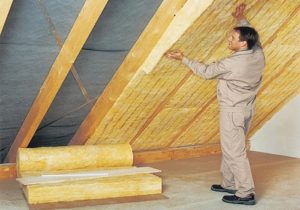
- From the floor itself, to the ridge, waterproofing is laid. The film should cover the entire surface, so that no open spaces form, it is necessary to overlap the canvases. The material is fixed on the rafters with a stapler.
- A crate is made of wooden slats, which are attached to the beams with a distance of 50-60 cm from each other.
- A heater is laid between the laths of the crate, its thickness should correspond to the width of the log. Plates are laid from the bottom of the room, moving to the top.
- From above, the cake is closed with a vapor barrier film, which is attached to the crate with thin slats, and the joints between the sheets are additionally glued with adhesive tape.
- A finishing finishing material is mounted to the crate, for example, lining or decorative panels.
If the ceiling and walls of the attic are separate parts of the room, then the walls are insulated as follows:
- Lay a layer of waterproofing.
- Make a wooden crate around the windows.
- At the bottom, along the entire length of the wall, a horizontal base beam is installed, and vertical racks are mounted from it in increments equal to the width of the insulation.
- A heat insulator is laid between the bars.
- Everything is covered with a vapor barrier film.
- A counter-lattice is made of thin rails to create a ventilation gap.
- Finishing is installed.
Insulation of the second floor in a house made of timber
The work consists of three stages:
- Thermal insulation of the interfloor ceiling.
- Thermal protection of walls.
- Insulation of the attic of the house.
We insulate the ceiling between floors
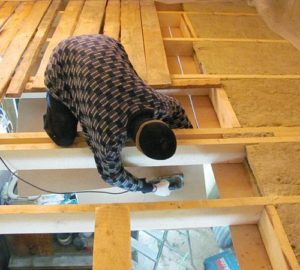
- In order for the insulation to turn out to be of high quality and effective, it is necessary to dismantle the floor of the second floor.
- The next stage is the laying of a vapor barrier layer. We wrote above that the vapor barrier of the second floor can be omitted, but in order to prevent the accumulation of condensate in the insulation and extend its service life, it is best to lay a vapor barrier film on the shields and beams.
- Further, the space between the beams is filled with thermal insulation, the material is laid very tightly so that there are no gaps and gaps between the plates and the ceiling. If expanded clay is used, then all cavities are filled with granules, and then they are well leveled.
- Then the insulation is covered with a waterproof film, on which a wooden floor is laid.
If thermal insulation cannot be done from the side of the second floor, then work is carried out from below in the following sequence:
- The ceiling of the first floor is dismantled.
- Waterproofing is attached to the floors with a stapler.
- Insulating mats are laid between the beams and fixed with wooden slats.
- The structure is closed with a vapor barrier film, which is fixed with a stapler.
- A ceiling covering is mounted, it can be drywall, chipboard, plywood sheets, etc.
Wall thermal protection
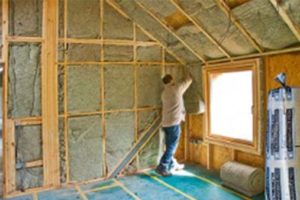
It should be noted the disadvantages of insulation from the inside of the house:
- the useful area of the room is reduced;
- the facade remains cold, which causes some cooling of the house;
- condensation may appear between the wall and the insulation and, as a result, mold may form.
With strict adherence to the technology of work, the negative consequences can be minimized.
- First, the cracks are caulked with natural materials, and then the wood is treated with antiseptic impregnations.
- Horizontal rails 20 mm thick are mounted.
- The waterproofing film is laid. It needs to be fastened tightly to the rails.
- Vertical racks of the counter-lattice are installed. The distance between the slats should be slightly less than the width of the insulation boards.
- Thermal insulation is laid in the space between the vertical slats.
- A vapor barrier layer is laid over the insulating material.
- Installation of decorative trim.
Insulation of the attic floor
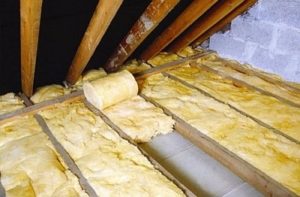
- Before you insulate the attic, you need to make a vapor barrier on the floor in the attic, which will become an additional barrier to the exit of heat from the house and prevent condensation from entering the insulation. To do this, the surface is covered with a vapor barrier membrane. The film must completely cover the entire floor area. The canvases are placed on top of each other with a small margin and glued together with adhesive tape. After that, they are fixed to the floor boards with a construction stapler.
- Insulation is being installed, the method is selected depending on the selected material. If slab insulation is used (mineral wool, polystyrene foam or polyurethane foam), it is laid in dense layers between the floor beams.Ecowool is applied by spraying with a high-pressure apparatus, all cavities must be well filled. Expanded clay is poured in a thick layer on the floor and leveled.
- Floor beams can become cold bridges to the house, so they also need to be insulated. To do this, a thin insulating material is laid on them.
- From above, the thermal insulation is again covered with a vapor barrier film, which, like the first time, is overlapped. The membrane is fixed to the beams with counter rails.
- The finishing stage is the flooring of the covering from boards or plywood.
Conclusion
The issue of insulation of ceilings and attic floors is not easy and requires a thorough approach.
Particular attention should be paid to the installation of hydro and vapor barrier, since the service life of the insulation depends on the tightness of these layers. Also, do not save on its thickness, otherwise you will spend a lot of time and effort, and the result will remain far from expected.
Recommended:
How to insulate a garage on your own How to insulate a concrete floor in a private house How to properly insulate an apartment
Warming the attic floor of the house allows you to save more heat inside the room, and not spend it on heating a cold attic. Well, if it is used as a utility room (technical attic) or as an attic, but if not? Then it is pointless to spend resources on heating an unheated attic space.
That is why it is worth making the insulation of the cold attic ceiling using heat-insulating materials. You can perform insulation from the side of the attic or from the side of the room (inside / outside). It is best to do this during the construction period of the building, or immediately before the final finishing of the room. But even during the operation of the house, there is no reason not to insulate the ceiling from the attic.

The thickness of the attic floor insulation is standardized using SNiP II-3-79 "Construction Heat Engineering". This manual contains detailed recommendations regarding the choice and formulas for calculating the resistance to heat transfer of various thermal insulation materials.
The calculations take into account not only the type of material, but also the average annual temperature, the duration of the heating season, the wall material of the house
The attic floor insulation technology depends on the material chosen.
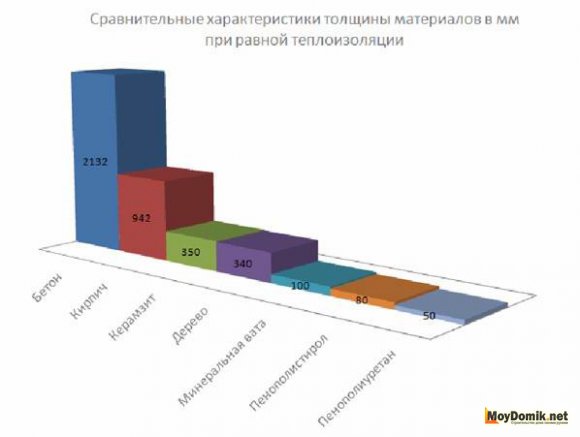
In this article we will consider the most popular heaters.
